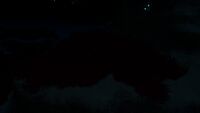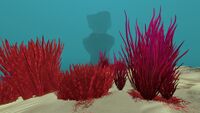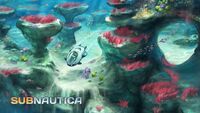Blood Grass: Difference between revisions
mNo edit summary Tags: Visual edit apiedit |
No edit summary Tag: rte-source |
||
| Line 6: | Line 6: | ||
|Attitude/s = [[:Category:Non-harvestable|Non-harvestable]] |
|Attitude/s = [[:Category:Non-harvestable|Non-harvestable]] |
||
|Biome/s = [[Grassy Plateaus]] |
|Biome/s = [[Grassy Plateaus]] |
||
|Active time = [[:Category:Cathemeral|Cathemeral (Day and Night)]]}} |
|Active time = [[:Category:Cathemeral|Cathemeral (Day and Night)]]}}{{Quote2|A common sea grass adapted to shallow, sandy environments.|[[PDA]]}} |
||
'''Bloodgrass''' is a type of [[flora]] found exclusively in the [[Grassy Plateaus]], which in turn derives the [[Biomes|biome's]] name from the large, wide-spread patches of '''Bloodgrass'''. |
'''Bloodgrass''' is a type of [[flora]] found exclusively in the [[Grassy Plateaus]], which in turn derives the [[Biomes|biome's]] name from the large, wide-spread patches of '''Bloodgrass'''. |
||
| Line 24: | Line 24: | ||
* Distinctive red coloration may be an adaptation to low wavelength light on the seabed, a deterrent against predators, or both |
* Distinctive red coloration may be an adaptation to low wavelength light on the seabed, a deterrent against predators, or both |
||
* Insufficient calories for human consumption |
* Insufficient calories for human consumption |
||
Predators: Reginald, spadefish, boomerang |
Predators: Reginald, spadefish, boomerang |
||
Assessment: Presence supports healthy biodiversity |
Assessment: Presence supports healthy biodiversity |
||
|} |
|} |
||
==Gallery== |
==Gallery== |
||
<gallery widths="200" spacing="small"> |
<gallery widths="200" spacing="small"> |
||
Revision as of 01:30, 13 November 2016
Bloodgrass is a type of flora found exclusively in the Grassy Plateaus, which in turn derives the biome's name from the large, wide-spread patches of Bloodgrass.
Appearance
Bloodgrass consists of a small group of dull red blades of tall grass. They tend to grow close to each other, forming vast patches.
Data Bank Entry
|
A common sea grass adapted to shallow, sandy environments.
Assessment: Presence supports healthy biodiversity |
Gallery
Trivia
- Bloodgrass was initially intended to release a "red smoky dye" when touched. Whether this will be implemented in future updates is unknown.
Lua error in package.lua at line 80: module 'Dev:Navbox' not found.




